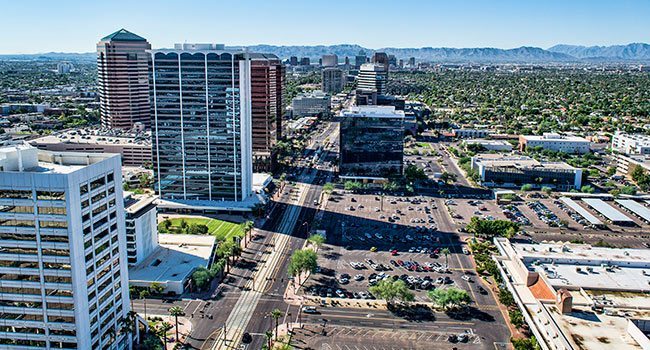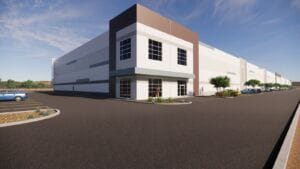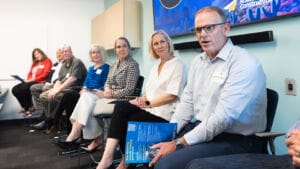 The seeds for Midtown’s success were planted more than a decade ago. The downturn brought a drought to the real estate market, but with a slow and steady recovery acting as the rain, those seeds are now growing and spurring additional growth.
The seeds for Midtown’s success were planted more than a decade ago. The downturn brought a drought to the real estate market, but with a slow and steady recovery acting as the rain, those seeds are now growing and spurring additional growth.
A culmination of factors led to the re-gentrification of Midtown, which is now home to new corporate headquarters, a bustling food and bar scene, revamped offices and new multifamily developments.
This wasn’t always the case though.
WHAT HAPPENED
Michael Crystal, managing director at Newmark Grubb Knight Frank, started his brokerage career in the Midtown market 12 years ago, and has witnessed its re-gentrification first-hand.
“Back then, it wasn’t cool to be a Midtown broker,” he says.
It was around that time, in the early 2000s, when City of Phoenix Economic Development Director Christine Mackay says, the central city experienced a flight to the suburbs of both companies and residents.
“People had forgotten about Midtown,” she says. “It wasn’t really in the conversation anymore.”
Once overshadowed between Downtown Phoenix and the Camelback Corridor, Crystal explains, Midtown was seen as a second-tier market only offering slightly cheaper rents and decent parking ratios. He adds, back in the day, there also weren’t many identifiable restaurants in Midtown other than Alexi’s at the base of the 3550 Tower on Central Avenue and a couple others.
Today, Midtown is very much part of the conversation, gaining more attention from companies, developers and residents. It was considered one of the emerging submarkets in Metro Phoenix last June at CoreNet Global Arizona’s Midyear Market Update: Brokers’ Perspective.
“The crux of the boom in Midtown is the urban movement,” says Mark Adams, principal at SmithGroupJJR.
Contributing to that movement was the opening of the light rail in 2008, which added a much needed tool to Midtown’s arsenal. It created alternative access to the central city from other core markets and an opportunity to provide employees with new housing options closer to work in Midtown.
Since then numerous multifamily projects have joined the fray in Midtown and others are coming down the pike.
Two projects currently under construction along the light rail include Edison Midtown, a 110-unit luxury mid-rise condominium complex located on Central Avenue, and Parc Midtown, a 306-unit apartment complex at Third Avenue and Indian School Road.
On the retail side, Midtown also offers convenient access to numerous retail hubs with shops and places to eat like the newly renovated Uptown Plaza at Central Avenue and Camelback Road.
HOW IT CHANGED
Similar to the Valley’s other core urban markets like Downtown Phoenix, Downtown Tempe or Old Town Scottsdale, Midtown now offers an urban environment with walkability, connectivity, a plethora of amenities and a true work-live-play setting.
While all the urban cores share similarities, each one also has a unique identity that it’s known for, except for Midtown, which changed after 2015, Crystal says.
Tempe has Arizona State University. Old Town Scottsdale has a lively nightlife scene. Downtown Phoenix has sports and entertainment venues.
The main difference that Crystal sees between Midtown and other urban cores is the fact it’s home to flagship hospitals for the state’s two largest hospital systems – Banner Health and Dignity Health.
When Banner, the state’s largest private employer, moved its corporate headquarters to Central Avenue and Thomas Road in 2015, it solidified Midtown as a contender and viable market option, Mackay says.
Kip Edwards, vice president of development and construction at Banner Health, describes the move as ideal for Banner’s employee base and operations because of its central location and connectivity to other markets.
“It’s a great place to be, to live and to play. It’s the benefits of downtown without the congestion,” Edwards explains. “You have the best of both worlds.”
Later, companies like Facility Source, an Ohio-based technology company, started to follow suit, relocating its corporate headquarters to the same area.
Mackay explains the growth of Midtown happened organically and quickly from there.
Office vacancies decreased from 38 percent in 2012 to less than 20 percent today, totaling approximately 3 million square feet of total absorption, she adds.
Building owners began retrofitting old office space to reflect popular market trends with more natural light, higher ceilings, open and flexible layouts in addition to first-floor retail space.
Adams says today’s office tenants want smaller floorplates and unique open incubator type spaces where people are work-sharing, which are popular with startup companies.
He worked on strategies for popular shared workspace projects in Midtown like MOD and Seed Spot — located within the 2828 E. Thomas building — that have proven to be viable and popular office concepts.
WHAT’S NEXT
Park Central Mall, a thriving outdoor mall back in 1961, was originally thought to be what was holding back the Midtown market from competing with other urban core markets.

Located in the heart of Midtown, older redevelopment plans for Park Central revolved around it becoming the next CityScape or Kierland Commons in the sense that it could be a catalyst for driving a lot of change for the area.
“But guess what,” says Crystal. “The rest of the market looks different and Park Central still looks the same.”
The redevelopment of Park Central wasn’t needed to bring back Midtown’s viability, but Crystal says, “Now when the redevelopment does happen, it will be the cherry on top.”
Whether it’s Park Central or another development that will help drive activity in the area, Adams is cautiously optimistic something big is still in store for Midtown.
Mackay predicts more strategic opportunities arising to add new density into the market “between office, multifamily, hotels additional retail and restaurants.”





